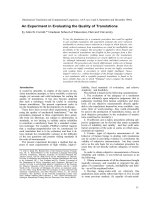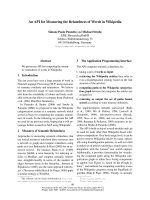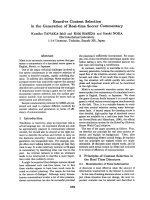báo cáo khoa học: "Carotid angiodysplasia complicated by the use of anti-hypertensive drugs during pregnancy: a case report" ppsx
Bạn đang xem bản rút gọn của tài liệu. Xem và tải ngay bản đầy đủ của tài liệu tại đây (228.6 KB, 3 trang )
CAS E RE P O R T Open Access
Carotid angiodysplasia complicated by the use
of anti-hypertensive drugs during pregnancy:
a case report
Viviane Ribeiro de Paula
1
, Laura Penna Rocha
1
, Giovanni Carlos Tiveron Jr
1
, Camila Souza de Oliveira Guimarães
1
,
Marlene Antônia dos Reis
1
, Beatriz Barco Tavares
2
and Rosana Rosa Miranda Corrêa
1*
Abstract
Introduction: Hypertensive syndromes in pregnancy are one of the leading causes of obstetric admissions into
intensive care units. They are related to changes in the central nervous system caused by a decrease in cerebral
perfusion pressure, indicated by an increase in intracranial pressure. These changes in pressure usually result from
acute injuries or a decrease in the mean arterial pressure due to iatrogenic action or shock. However, other
vascular disorders may contribute to similar occurrences.
Case presentation: A 15-year-old girl was admitted to our hospital complaining of severe headaches since the eighth
month of pregnancy, and presented with an arterial blood pressure of 180/120 mmHg. The diagnostic hypothesis was
pre-eclampsia. Our patient’s blood pressure levels remained elevated, and she was submitted to a cesarean section.
After the procedure, she was referred to our infirmary, presenting with a blank distant look and with no interaction with
the environment, dyslalia, and labial and upper and lower right limb paresis. She was confused and unable to speak,
but responded to painful stimuli as she conveyed abdominal pain at superficial and deep palpation. The hypothesis of
post-partum psychosis was suggested. She was then transferred to our intensive care unit, maintaining an impassive
attitude in bed but reacting to external stimuli. Results of a computed tomography scan revealed ischemic infarction of
the territory of her left middle cerebral artery. A selective cerebral arteriography showed bilateral occlusion of her
internal carotid artery in the intracranial position, prebifurcation and angiodysplasia in the cervical segments of her
internal carotid artery. Sixteen days after hospital admission, our patient died.
Conclusion: This data shows the need for careful monitoring of hypertensive syndromes in pregnancy cases,
especially in cases with a history of chronic hypertension or with vascular alterations, It also highlights the need for
constant supervision of blood pressure levels during the use of anti-hypertensive medications.
Introduction
Cardiovascular diseases during pregnancy are repre-
sented primarily by gestational hypertension syndromes
and are an important cause of maternal morbidity,
accounting for about 20-50% of obstetric admissions in
the intensi ve care unit, and 15% of gestational deaths in
Brazil [1,2].
Besides general systemic alterations, hypertensive syn-
dromes in pregnancy (HSP) are related to changes in the
central nervous system caused by the decrease of the
cerebral perfusion pressure, indic ated by the increase of
the intracranial pressure. This can result from acute inju-
ries or a decrease in the mean arterial pressure (MAP) due
to iatrogenic action or shock. However, other vascular dis-
orders may contribute to similar occurrences. The nervous
system maintains cerebral autoregulation as a response
mechanism to alterations in blood pressure levels. This
adjusts the balance between cerebral perfusion pre ssure
and cerebrovascular resistance, contributing to the perfu-
sion of the nervous system, and also responsible for the
balance of blood flow to vital organs [3].
In the current study we present the case of a pregnant
woman with alter ed blood pressure levels, signs of loss
of cerebral autoregulation and impairment of cerebral
* Correspondence:
1
Discipline of General Pathology, Department of Biological Sciences,
Universidade Federal do Triângulo Mineiro, Uberaba, Minas Gerais, Brazil
Full list of author information is available at the end of the article
de Paula et al. Journal of Medical Case Reports 2011, 5:415
/>JOURNAL OF MEDICAL
CASE REPORTS
© 2011 de Paula et al; licensee BioMed Central Ltd. This is an Ope n Access article distributed under the terms of the Creative
Commons Attribution License (http://creative commons.org/license s/by/2.0), which permits unrestricted use, distribut ion, and
reproduction in any medium, provided the original work is properly cited.
perfusion pressure, related to the manipulation of MAP
and previous presence of carotid angiodysplasia.
Case presentation
A 15-year-old girl was admitted to our hospital complain-
ing of severe headaches since the eighth month of preg-
nancy, which had worsened in the last five hours. The
following information was observed in the prenatal card:
G1P0A0; gestational age: 37 weeks (estimated by date of
last menstrual period); type O+ blood and negative serol-
ogy. On examination our patient presented an arterial
blood pressure of 180/120 mmHg, her uterine cervix was
20% effaced, with impervious external orifice and cephalic
presentation. The diagnostic hypothesis was pre-eclampsia
and routine investigations were requested to diagnose the
HSP. After the tests, the diagnostic hypothesis changed to
gestational hypertension. As our patient continued with
elevated blood pressure levels, s he was submitted to a
cesarean section on the fourth day in hospital, delivering a
male live baby with no i ntercurrences. Af ter the proce-
dure, she was referred to our infirmary, presenting a blank
distant look and with no interaction with the environment.
On examination she presented with dyslalia, and labial and
upper and lower right limb paresis. During an examination
six days after hospital admission, our patient was confused
and unable to speak, but responded to painful stimuli as
she conveyed abdominal pain at superficial and deep pal-
pation. Moreover, she had a hematoma on the upper
region of the surgical wound and physiological lochia. The
hypothesis of post-partum psychosis was suggested and a
careful neur ological evaluation requested. She was admi-
nist ered the following drugs in hospital: nifedipine 1 mg,
methyldopa 500 mg, 750 mg paracetamol, betamethasone,
oxytocin, tenoxicam, promethazine, diclofenac sodium,
cephalexin, and haloperidol. She was then transferred to
the teaching hospital on the same day, and admitted to
our intensive care unit, maintaining an impassive attitude
in bed but reacting to external stimuli. She also emitted
incomprehensible sounds, presented a blank look, with
upward conjugated deviation of the eyes and mydriatic
pupils reactive to light. She had Glasgow Coma Scale
(GCS) score of nine points (2 +5 +2). Our patient was
then submitted to orotracheal intubation with mechanical
ventilation and central venous access through her right
internal jugular vein, in addition to continuou s sedatio n.
Computed tomog raphy (CT) of her skull and pelvis were
requested. Results revealed tomography findings consis-
tent with ischemic infarction of the territory o f her left
middle cerebral artery, but no pelvic alterations were
observed. Our patient showed progressive worsening of
the neurological symptoms, hyperthermia, tonic-extensor
crisis, difficulty in breathing and scored four points in the
GCS. A repeat skull CT revealed ischemic lesions in the
mean cerebral system affecting her basal ganglia and
parietal lobe, with proper filling of venous sinuses and no
signs of meningeal inflammation. During this period,
her blood pressure levels remained elevated (MAP 140-
150 mmHg) and refractory to medication. In addition, our
patient presented with neuropsychomotor agitation and
periods of tachycardia and systemic arterial hypertension
alternating with bradycardia and normotension. An urgent
selective cerebral arteriography was requested; this showed
bilateral occlusion of her internal carotid artery in the
intracranial position, pre-bifurcation and angiodysplasia in
the cervical segments of the internal carotid artery. Sixteen
days after hospital admission, there was a worsening of our
patient’s condition and she died. Brain death as a conse-
quence of bilateral obstruction of the internal carotid was
certified as the cause of de ath.
Discussion
In this c ase, our patient presented with elevated blood
pressure levels and had an initial diagnostic of HSP.
Although hypertension is one of the parameters for the
diagnosis of HSP, other aspects must be consider ed; for
example, the development of brain alterations, frequent
in severe cases of HSP [4]. However, in this case, even
with the administration of anti-hypertensive drugs and
initial control of blood pressure levels, the brain altera-
tions persisted.
Brain alteratio ns a re rel ated to cha nges in MAP, but
when they exceed the levels of regulation they are asso-
ciated with a reduction of cerebral blood flow [3], being
directly proportional to the cerebral perfusion pressure.
Brain autoregulation is related to the ability to increase or
decrease the metabolic demand, or to maintain the flow
despite the increase or the reduction of the systemic blood
pressure [5,6]. When the MAP exceeds the limits of auto-
regulation, the brain extracts more oxygen to compensate
for the reduction in blood flow, so manifestations such as
cerebral edema, reduction in the alertness level, migraine,
mental confusion and anxiety, are observed in cases of fail-
ure in the mechanism of autoregulation [ 3,5,6]. High
blood pressure for long periods of time, caused by chronic
vascular lesions before pregnancy, influences the cerebral
autoregulation mechanism, whi ch, in thi s case, may have
been affected by the use of anti-hy pertensives. Some stu-
dies demonstrate that there must be a reduction of 25% in
the MAP within the first hour [5]. However, reports on
the duration of hypertension before pregnancy, the nature
of the underlying disease before the treatment and moni-
toring of MAP reduction time were not found in our
patient’s medical records. This information could confirm
that the action of the anti-hypertensive drugs was respon-
sible for the cerebral alterations in our case.
Another diagnostic hypothesis related to the neuro-
logical alterations presented was post-p artum psycho-
sis. About 0.1-0.2% of psychiatric disorders during the
de Paula et al. Journal of Medical Case Reports 2011, 5:415
/>Page 2 of 3
post-partum period are represented by psychosis, char-
acterized by the sudden onset of periods of psychotic
mood with serious mental disorders within two to
three weeks of birth. The classical symptoms are men-
tal confusion, psychomotor agitation, anxiety and
insomnia, evolving to manic, melancholy or even cata-
tonic forms [7]. Despite the presence of similar symp-
toms, and the severity of our patient’ s clinical
manifestations, especially prolonged low levels of con-
sciousness characterized by low electrocardiogram
scores, this hypothesis was rejected.
Carotid angiodysplasia was diagnosed by angiography
as the underlying disease. Vascular malformation or
angiodysplasia is characterized by endothelial hyperplasia
and can be classified as hemangioma or as vascular mal-
formation itself. Histologicall y, hemangiomas are charac-
terized by endothelial hyperplasia during the proliferative
phase, and by fibrosis, fatty infiltration and cell d ecrease
in the involution phase. They are not present at birth,
developing during the first months of life, and in 95% of
cases they undergo a regression process that can be short
or extend until the age of ten. As for malformations, the
lesionsarepresentatbirth,growatthesamerateasthe
body and do not regress spontaneously. They consist of
abnormal collections of blood vessels with the endothe-
lium preserved and can be subdivided into arterial,
venous and lymphatic vessels or a combination of them
all [8,9]. Although hemangiomas regress at the age of ten,
our patient’ s young age and the absence of an autopsy
examination did not allow a clear distinction between the
two forms of angiodysplasia in this case.
Conclusion
The present study demonstrated a case of a hypertensive
pregnant patient with carotid angiodysplasia and decom-
pensation of cerebral autoregulation possibly caused by
the use of anti-hypertensive drugs. This data shows the
need for careful monitoring of HSP cases, especially in
cases with a history of chronic hypertension or with vascu-
lar alterations, as well as constant supervision of the blood
pressure levels during the use of anti-hypertensive
medications.
Consent Statement
Written informed consent was obtained from the patient’s
Father for publication of this case report and any accom-
panying images. A copy of the written consent is available
for review by the Editor-in-Chief of this journal.
Acknowledgements
This work was financially supported by: Conselho Nacional de
Desenvolvimento Científico e Tecnológico, Coordenação de
Aperfeiçoamento de Pessoal de Nível Superior, Fundação de Amparo à
Pesquisa do Estado de Minas Gerais and Fundação de Ensino e Pesquisa de
Uberaba.
Author details
1
Discipline of General Pathology, Department of Biological Sciences,
Universidade Federal do Triângulo Mineiro, Uberaba, Minas Gerais, Brazil.
2
Faculdade de Medicina de São José do Rio Preto, São José do Rio Preto,
São Paulo, Brazil.
Authors’ contributions
VRP made significant contributions to the conception and acquisition of the
data and was engaged in the design of the present study. LPR and CSOG
participated in the sequence alignment and drafted the manuscript. BBT
participated in the design and coordination of the study. MAR and RRMC
were involved in drafting the manuscript and revising it critically for
important intellectual content, providing general supervision for the research
group and approved the final version to be published. All the authors read
and approved the final manuscript.
Competing interests
The authors declare that they have no competing interests.
Received: 21 October 2009 Accepted: 25 August 2011
Published: 25 August 2011
References
1. Bajwa SK, Bajwa SJ, Kaur J, Singh K, Kaur J: Is intensive care the only
answer for high risk pregnancies in developing nations? J Emerg Trauma
Shock 2010, 3(4):331-336.
2. Corrêa RR, Gilio DB, Cavellani CL, Paschoini MC, Oliveira FA, Peres LC,
Reis MA, Teixeira VP, Castro EC: Placental morphometrical and
histopathology changes in the different clinical presentations of
hypertensive syndromes in pregnancy. Arch Gynecol Obstet 2008,
277(3):201-206.
3. Zeeman GG: Neurologic complications of pre-eclampsia. Semin Perinatol
2009, 33(33):166-172.
4. Cipolla MJ, Sweet JG, Chan SL: Cerebral vascular adaptation to pregnancy
and its role in the neurological complications of eclampsia. J Appl Physiol
2011, 110(2):329-339.
5. Galvin SD, Celi LA, Thomas KN, Clendon TR, Galvin IE, Bunton RW,
Ainslie PN: Effects of age and coronary artery disease on cerebrovascular
reactivity to carbon dioxide in humans. Anaesth Intensive Care 2010,
38(4):710-717.
6. Vidt DG: Management of hypertensive emergencies and urgencies. In
Hypertension primer 2 edition. Edited by: Izzo JL Jr, Black HR. Baltimore:
Williams and Wilkins; 1999:437-440.
7. Doucet S, Jones I, Letourneau N, Dennis CL, Blackmore ER: Interventions
for the prevention and treatment of postpartum psychosis: a systematic
review. Arch Womens Ment Health 2011, 14(2):89-98.
8. Mulliken JB, Glowacki J: Hemangiomas and vascular malformations in
infants and children: a classification based on endothelial characteristics.
Plast Reconstr Surg 1982, 69(3):412-422.
9. Lourenço MA, Gomes CS, Beffa CV, Picheth FS: Utilização de álcool
absoluto no tratamento das malformações venosas. Radiol Bras 2006,
34:23-27.
doi:10.1186/1752-1947-5-415
Cite this article as: de Paula et al.: Carotid angiodysplasia complicated
by the use of anti-hypertensive drugs during pregnancy: a case report.
Journal of Medical Case Reports 2011 5:415.
de Paula et al. Journal of Medical Case Reports 2011, 5:415
/>Page 3 of 3









